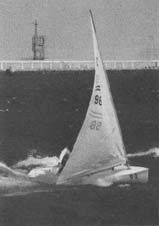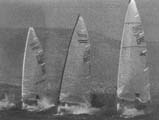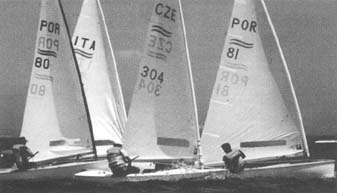| 18. The 'Perfect' Mast |
by Antonio Latini |
|
The relationship between the Finn sailor and his mast is really important and I think there is nothing comparable in the sport of sailing. It's a real love and hate relationship. There's no doubt that the mast, together with the sail, is the most important part of the Finn equipment. It's easy to imagine how much time and energy a Finn sailor dedicates to improving the performance of his rig. Sometimes it becomes an obsession for the Finn sailor. As a consequence every Finn sailor expects a 'magic' mast from the mast maker.
After the introduction of carbon-fibre in Finn masts there has been a real revolution and at first we all tried different solutions to the problems of design, aerodynamics, materials, construction methods and mast bend.
|
 |
Design and Aerodynamics
The rules of the Finn class allowed us to build an aerodynamic profile that we call the 'wing mast'. Before the 'wing' we built masts with elliptical or round sections. The shape of the mast for a Finn does not have a big impact on its performance, even if it has been demonstrated that a 'wing' mast is aerodynamically more efficient. In practice this advantage is very small. The mast on a Finn does not rotate completely because it's restricted by the boom and this fact means that the 'wing mast' does not reach the ideal angle of incidence to the wind. Another fact is
|
 |
|
that the Finn is a very slow boat and often the air flow on the sail is not laminar. The combination of the mast and the sail is the most important element of the problem, in spite of the mast shape (round or wing). Anyway, the 'wing' mast is now standard because at the very highest levels of competition, even a small advantage is important and everybody wants the 'best'.
Materials and Construction
There are several types of carbon fibre, and the mechanical characteristics of the fibres are very different from a type to another. We have 2 important specifics: Modulus and Ê number. |
The modulus shows the tenacity of the fibre and the Ê number shows the size of the fibre. Of course the price of the fibre is much higher for the high modulus and the low Ê carbon. Then we have carbon fibres like woven clothes and unidirectionals. We use both types in order to get the right mast bend, by changing the orientation of the fibres, and making the mast strong enough so that it won't break. This is what makes the Finn mast difficult to build: it's not the only problem to build a light and strong mast, but a light, strong and 'perfect' bending mast. . . !
Carbon fibres can be pre-preg or not. In the first case they are impregnated with epoxy resin by the factory and they need to be thermo cured at high temperatures (from 60 to 120 °C) during moulding . We have to keep them refrigerated until we use them. In the second case they have to be impregnated by hand or with a machine with an epoxy resin that can be moulded at low temperatures (20-25 °C) and then post-cured at high temperature to reach the best mechanical characteristics. The pre-preg are much more expensive but we have more accurate control of the quantity of resin in the laminate. The dry fibres allow us to use simpler methods and also to keep the price of the mast down. There are different methods for moulding a mast and every mast maker has his own tricks.
|
 |
|
|
This practice was very popular with the round mast at the beginning of the 'carbon era', but it's more dangerous with wing masts because the thickness of the walls of a wing mast is generally thinner than a round mast. |
 |
Mast Bend
We use the cantilever test to measure the mast bend. 12 kg is suspended from the tip with the mast bent both fore and aft and sideways. Then we put a line from the measurement band at the gooseneck to the measurement band at the tip and measure the deflection at top quarter, middle and bottom quarter.
Also we measure the tip deflection before and after applying the 12 kg. weight. This test gives a general idea of the bend characteristics. It is also interesting to calculate the percentage between the middle measurement and the measurements at the top and bottom quarters.
|
|
These measurements help the sailmaker to determine the luff curve of the sail. It is also important to measure the weight and centre of gravity - they have to be near the minimum. Every sailor has to decide what is the best bend for his weight and preferences. The heavier helmsmen can use a stiffer and more powerful mast. However, it is very important to have an all round mast in order to have good performance in all conditions.
Top sailors are always testing a lot of mast/sail combinations and they spend a lot of time on the water so they often know exactly what they are looking for. It is not the same for the week-end sailors and it's more difficult for them to know exactly what is the best combination to use. In any case the choice of the mast and sail is part of Finn sailing and it's always one of the favourite topics of conversation between Finn sailors.
|
 |
|